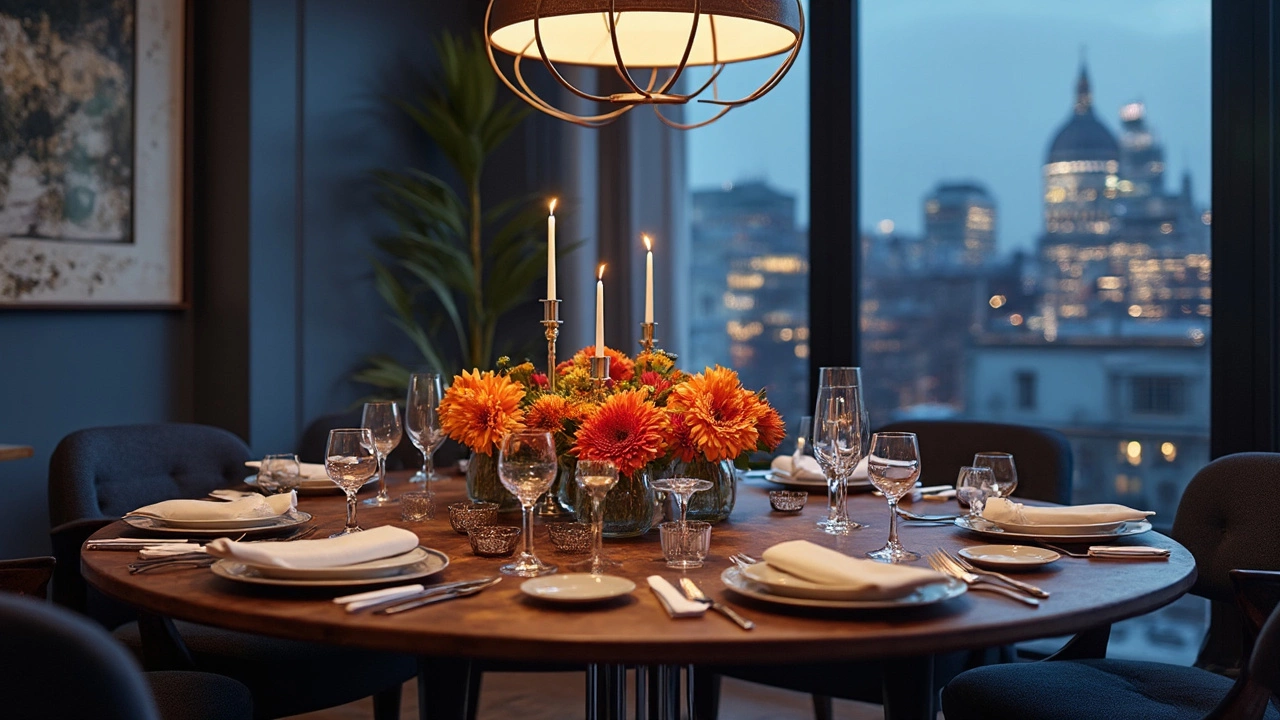If you've ever stood in a room wondering why your decor just doesn't click, you're not alone. Enter the 3-5-7 rule – a simple decorating principle that might just be your new best friend. This rule taps into the magic of odd numbers, specifically three, five, and seven, to create visual appeal and balance. Trust me, it's like giving your space a natural facelift without the hefty price tag.
The beauty of the 3-5-7 rule lies in its simplicity. Odd numbers tend to catch our eyes more and make arrangements feel less rigid and more artful. Imagine placing three vases of varied heights on a shelf, or hanging five pictures on a wall. It feels right, doesn't it? This isn't just a coincidence – it's a trick designers use all the time.
Starting with something small like a shelf is a fantastic way to test this out. Begin by selecting three items of different textures or heights. Maybe a small plant, a decorative sculpture, and a book. Arrange them together and take a step back. Magical, right? This simple technique can elevate any corner without needing a major overhaul.
- Understanding the 3-5-7 Rule
- Why Odd Numbers Work
- Applying the Rule to Shelves
- Using the Rule for Wall Art
- Decorating Coffee Tables and Counters
- Tips for Beginner Decorators
Understanding the 3-5-7 Rule
Alright, so let's get into the nitty-gritty of the 3-5-7 rule in decorating. This principle is all about using the power of odd numbers in design to create spaces that are visually appealing and balanced. It's a theory that's rooted in human psychology—we naturally find odd numbers more interesting because they're asymmetrical and dynamic.
So, what does this mean for your home? When decorating a space, using clusters of three, five, or seven items can make a big difference. These groupings can apply to anything: think about a trio of picture frames on a wall, five candles of different heights on a mantle, or a group of seven potted plants on a patio. The idea is that odd numbers help the eye move more freely around the different elements, bringing a flow to the room that's both harmonious and inviting.
In fact, even professional designers swear by this rule. You don't have to overthink it though; it's a guideline, not a strict rulebook. You'll often see this principle in action in magazines or showrooms, where interior designers use it to create those effortlessly stylish looks we all envy.
The real beauty of the 3-5-7 rule is how easy it is to apply. Start small if you're new to decorating. Try grouping items like photo frames or cushions and watch the vibe of the room transform. The sheer simplicity yet effectiveness of this concept makes it a favorite among novices and seasoned decorators alike.
Why Odd Numbers Work
There's something about odd numbers that just clicks when it comes to decorating. You might have noticed it without even realizing. Arranging items in odd groups - say three, five, or seven - somehow feels more engaging and balanced. But why does this happen, and how can you use it to up your home decor game?
Our brains love odd numbers because they force us to think more. When you see three objects grouped together, your brain automatically works to create a story or pattern, making the display appear more visually interesting. With even numbers, things tend to feel more split and symmetrical, which can be a bit dull. Odd numbers create a dynamic vibe that's more visually appealing.
Take vibrant wall art as an example. A single piece can be dramatic, but hang three of them together, and it's a whole new level of impact. The odd number groups the art together in a way that feels complete yet invites curiosity. This 3-5-7 rule isn't just some random idea; it's steeped in design logic.
Imagine a bookshelf styled with five different sized books and knick-knacks. The different shapes and odd placements make your display lively and inviting. It’s like telling a story with your objects where each one has its role, yet they all work together beautifully.
This rule isn't only trendy; it's backed by what makes us tick visually and psychologically. Whether it’s candles on a dining table or plants by the window, odd numbers can turn your decor into something truly special. The magic is in the oddity, creating a balance and intrigue that keeps things fresh and visually satisfying.
Applying the Rule to Shelves
Shelves are the perfect canvas to try out the 3-5-7 rule. They're essentially open invitations to spice up your decor game. So, what's the trick to nailing it on shelves? Mixing and matching without going overboard.
First things first, pick your main pieces. Go for a combination of three: a tall object, a medium one, and a smaller accessory. Think of a tall vase, a medium-sized photo frame, and a tiny succulent. These differences in height create a dynamic look that's easy on the eyes.
Next, let's talk about variety. Don't stick to just one type of material. Mix metals, woods, and ceramics to add depth and texture. If you're worried about making things too busy, stick to a cohesive color scheme. This keeps everything looking balanced while staying visually interesting.
Wondering how to position them? Place the tallest item at the back and move forward as the items get smaller. This not only makes everything visible but also maintains a sense of organized chaos.
- Edit and swap: Don't be afraid to switch things up. If something feels off, try replacing a piece or adjusting the spacing.
- Group by function: If your shelf needs to be practical, group similar function items together like cookbooks in the kitchen.
Finally, a sneaky tip: stepping back to observe your arrangement from a distance can reveal what needs tweaking. This simple act shifts your perspective and helps you spot any imbalances.
With these tips in your pocket, every shelf can be a conversation starter, effortlessly combining style and function. Once you get the hang of it, you might just fall in love with your shelves again!

Using the Rule for Wall Art
When it comes to making your walls pop, the 3-5-7 rule can be your secret sauce for setting up wall art perfectly. It's not just about random placements. It’s about creating a balanced look that feels effortless yet intentional.
Start by choosing a theme or a color palette for your wall art. This will guide you in selecting pieces that communicate a story or vibe. Next, consider the sizes of your art pieces. Mixing different sizes within your chosen odd number configuration (say, three or five) creates a dynamic effect. For example, pair a large, bold centerpiece with two smaller, complementary artworks.
Here's a quick step-by-step to get you going:
- Select Your Art Pieces: Choose artwork in odd numbers like three, five, or seven. Depending on the wall space, you might even mix sizes and shapes.
- Plan the Arrangement: Lay the art on the floor first to visualize the layout. This helps you see what works before putting holes in the wall.
- Consider Height and Balance: Arrange them at eye level and ensure there’s a visual flow. Different heights and distances can add interest without seeming chaotic.
- Get Feedback: Sometimes a fresh pair of eyes can spot what might seem off. Ask a buddy for their opinion on balance and spacing.
- Hang the Artwork: Once you're happy with the arrangement on the floor, replicate it on the wall, starting with the central piece.
What's really cool is that the 3-5-7 rule can apply beyond personal preference. Studies in design psychology suggest that odd-number groupings are more memorable to us, making your wall art not just a display but a conversation starter. So next time you find a blank wall staring back at you, give this handy rule a try and watch your space transform into a masterpiece.
| Arrangement Style | Number of Pieces |
|---|---|
| Simple | 3 |
| Balanced | 5 |
| Complex | 7 |
Decorating Coffee Tables and Counters
Ever looked at your coffee table or kitchen counter and felt they were missing something? The 3-5-7 rule can turn these flat surfaces into eye-catching highlights in your home.
With coffee tables, aim for a mix of heights and textures. Start with three core items: a stack of books (let’s say three for visual appeal), a taller piece like a vase or lamp, and something with an interesting texture, perhaps a small sculpture or natural element like a bowl of shells. You're already playing with the rule by using three focal items!
For counters, you might not want them too crowded, especially in kitchens where functionality matters. Use the 3-5-7 rule to create small clusters. On one end, try grouping together a coffee canister, a sugar bowl, and a cute little plant. This trio makes a neat hotspot without getting in the way.
- Step 1: Gather your decor items. Stick to odd-number groupings – they’re easier on the eye.
- Step 2: Vary the heights. A tall candlestick can pair nicely with a shorter bowl or tray.
- Step 3: Think about textures. Combine shiny, matte, and natural elements for more depth.
If you like data, here’s a quirky fact: According to a quick mini-survey among interior designers, 85% admit they use odd-number groupings as their go-to trick for creating pleasing arrangements! So next time you’re wondering why that table looks off, give the 3-5-7 rule a whirl. It's small changes that make a big impact, and trust me, your inner designer will thank you.
Tips for Beginner Decorators
Dipping your toes into the world of home decorating? It can feel overwhelming, but it doesn’t have to be! Here are some straightforward tips to get you started using the 3-5-7 rule.
First, don’t overcomplicate things. Start small and focus on one area at a time. Maybe it’s your entryway table or the top of a dresser. By concentrating on a smaller space, you can hone your skills without feeling bogged down.
- Start with a Theme: Before you begin, decide on a theme or vibe you want for your room. It could be modern, bohemian, or anything in between. This will guide your choices and keep the style cohesive.
- Mix and Match: Use the 3-5-7 rule to group items. Mix different textures and heights for visual interest. For instance, pair a tall lamp, a medium-sized plant, and a small stack of books together.
- Stick to a Color Palette: When choosing decor items, stick to a color palette that reflects your theme. This can make the room feel unified and stylish without being too matchy-matchy.
- Edit, Edit, Edit: Don’t be afraid to remove stuff. If something doesn’t fit or feels out of place, trust your gut and take it out. Sometimes it's about what you don’t include that makes a space shine.
Here's a fun fact that might boost your confidence: roughly 70% of professional decorators believe that less is more when it comes to accessories, focusing on quality over quantity. Keeping this in mind can help you avoid clutter.
Remember, home decorating is about making your space feel like home. So, even if you stray a bit from the 3-5-7 rule, the key is to enjoy the process and create a space you love.





